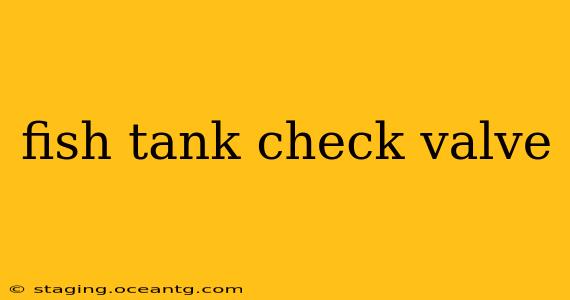Maintaining a healthy aquarium environment requires precise control over water flow. Check valves play a crucial role in this, preventing backflow in your filtration system and other vital components. This comprehensive guide will delve into the intricacies of fish tank check valves, answering common questions and providing essential information for aquarium enthusiasts of all levels.
What is a Check Valve in a Fish Tank?
A check valve, also known as a one-way valve or non-return valve, is a simple yet critical component in many aquarium setups. Its primary function is to allow water to flow in only one direction. This prevents water from flowing back into the pump or other parts of your system when the pump is turned off or experiences a power outage. This protection safeguards your equipment and maintains the integrity of your carefully balanced aquarium ecosystem. They come in various sizes and materials, each suited for different applications and pressure levels.
Why Use a Check Valve in My Aquarium?
Using a check valve in your fish tank offers several significant advantages:
- Prevents Backflow: This is the most important function. Backflow can contaminate your filtration system, potentially introducing harmful bacteria or debris back into your aquarium water.
- Protects Equipment: Backflow can damage delicate aquarium components such as pumps and filters, leading to costly repairs or replacements.
- Maintains Water Pressure: Check valves help maintain consistent water pressure within the filtration system, ensuring optimal performance.
- Simplifies Maintenance: Prevents water from draining back into the tank during maintenance tasks like filter cleaning.
What are the Different Types of Fish Tank Check Valves?
Several types of check valves cater to various aquarium needs:
- Swing Check Valves: These are the most common type, using a hinged flap that opens with water pressure in one direction and closes to prevent backflow.
- Ball Check Valves: These utilize a small ball bearing to seal the valve when the water flow reverses. They're often more compact than swing check valves.
- Diaphragm Check Valves: These feature a flexible diaphragm that acts as a seal, opening under pressure and closing when the flow reverses. They're often more durable than other types.
Where Should I Install a Check Valve in My Aquarium?
The optimal location for a check valve depends on your specific setup. Generally, it's best placed between the pump and the filter or any other component where backflow could occur. Precise placement instructions will vary depending on the manufacturer's recommendations for your chosen equipment.
How Do I Choose the Right Size Check Valve for My Aquarium?
Selecting the appropriate size is vital. Too small, and it may restrict water flow; too large, and it might not seal effectively. Always consult the specifications of your pump and filter to determine the required flow rate and choose a check valve that matches or slightly exceeds this capacity.
How Often Should I Check My Aquarium's Check Valve?
Regularly inspect your check valve for any signs of wear, tear, or malfunction. Look for leaks, cracks, or any difficulty in opening and closing. While not requiring frequent replacement, a damaged check valve should be replaced promptly to avoid potential problems.
Can I Use a Check Valve with Any Type of Aquarium Filter?
Generally, yes. Check valves are compatible with most aquarium filters. However, some specialized filter systems may have unique requirements, so refer to the filter manufacturer's instructions.
What Happens if My Check Valve Fails?
A failed check valve can lead to backflow, potentially contaminating your filter, damaging equipment, and jeopardizing the health of your fish. A regular inspection schedule is essential for preventing this scenario.
By understanding the role and function of check valves in your aquarium system, you can ensure the optimal health and longevity of your fish and equipment. Remember always to choose the correct size and type for your specific setup and to regularly inspect it to maintain the efficiency and health of your aquarium.
